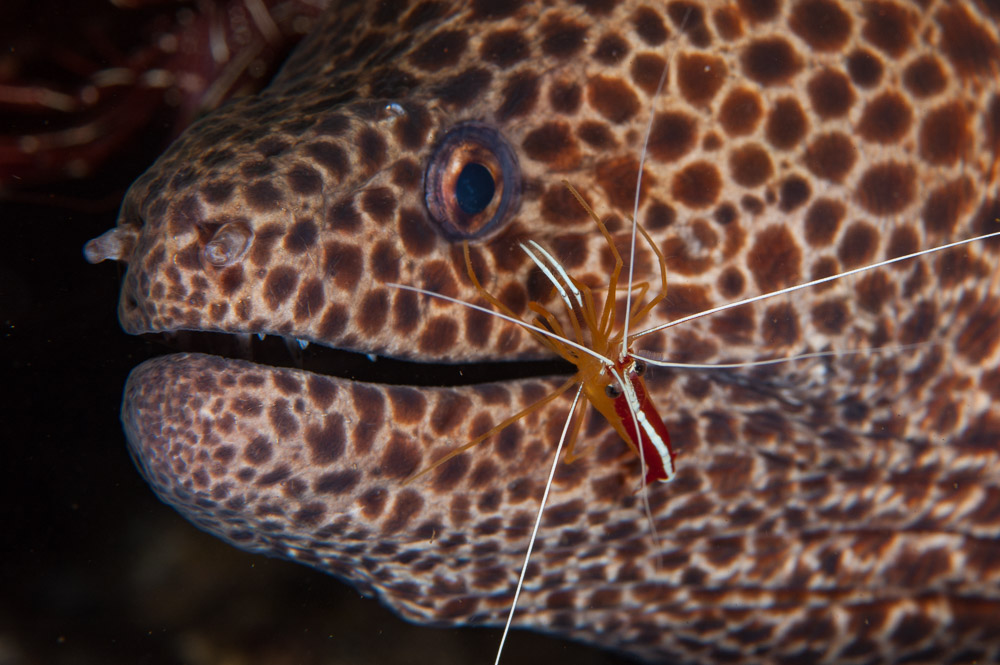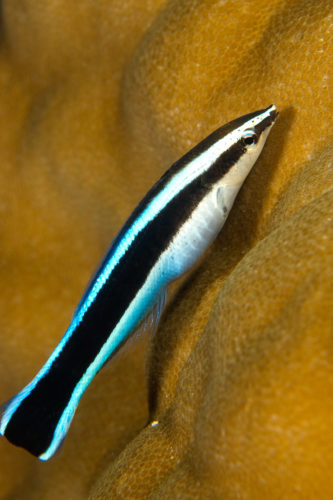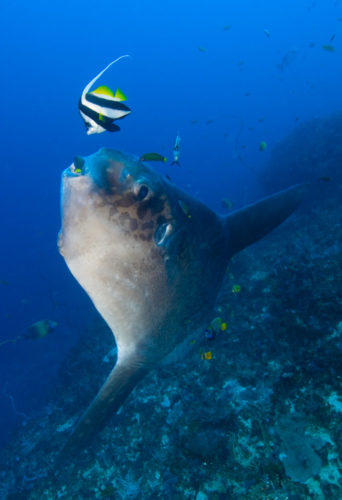
Cleaning stations, you have probably heard the term but perhaps you weren’t sure what it means? Have you ever wondered how marine life keeps clean? You would think that living in water 24 hours per day means you don’t get dirty, but is that true? As many people know, there are many parasites and other contaminants in salt water. Many fish and marine mammals are affected by these parasites which can be real pests. Of course wonderful mother nature provides a way for animals to remove these annoying parasites. Through the wonder of evolution and specialization, many species of marine life have become special “cleaners”.

Blue Stripe Cleaner Wrasse
What is a Cleaning Station?
A cleaning station is a particular coral head or portion of reef where “cleaners” live. What exactly is a cleaner I hear you ask? Cleaners come in a variety of species including shrimp, wrasse, butterfly fish, angel fish, and more! Each of these has evolved to fill a particular niche. Shrimp tend to live on coral heads and rocks in large groups and pick parasites off a variety of visitors such as eels and small to medium sized fish. Larger animals such as manta rays and sharks will often visit large coral formations where a variety of small wrasse or butterfly fish live. When it comes to sunfish, they prefer to visits a particular reef where very mobile fish like angel fish or banner fish will find them and fill the role of a cleaner.

Sunfish being cleaned by banner fish
How Does it Work?
If you have ever seen a fish cleaning you know the drill. However, for those who have never witnessed this behaviour it’s pretty amazing to watch. Some of the most frequent visitors to cleaning stations are actually predators. Upon a diver’s first encounter with an eel cleaning, many may think the poor innocent little cleaner fish is about to be eaten! Eels will open their mouth wide open and a fish or shrimp will dutifully pop into it’s mouth in order to clean the teeth. If you have not seen this behaviour before it looks like the eel is about to eat the cleaner! However, upon longer inspection the interaction can go on for a long time with no parties injured in the process. Sharks, barracuda, groupers and other large predators who are often in attendance at cleaning stations. Seeing a shark “hovering” with it’s mouth wide open is quite a sight to see.
Manta Ray Cleaning Stations
Perhaps the most sought after cleaning experience for divers is to encounter manta rays at a dedicated cleaning station. Many of the world’s premiere dives sites in such places as Yap, Indonesia, Palau, and the Maldives are cleaning stations. It’s incredible to watch manta rays numbering from one to a dozen line up for a cleaning. Cleaner wrasse, butterfly fish, and angel fish are some of the most common fish to clean these magnificent animals. It’s incredible to watch the interaction between the rays when they are in large numbers, there is definitely a social order between them. Most divers can spend hours watching these graceful rays perform acrobatics without boredom setting in.
If you have never encountered a cleaning station, this is something to watch out for on your next dive. When swimming past large rocks or coral heads, have a look for fish that seem to be acting a little strangely. This is a good sign they may have a shrimp or cleaner wrasse pulling at their teeth or skin. Slowly move closer and give the marine life room to act naturally. Then settle in to watch nature in it’s most pure form. The Tulamben area in Bali is dotted with dozens of interesting cleaning stations, read a little more about Tulamben dive sites on our Bali Diving guide.


